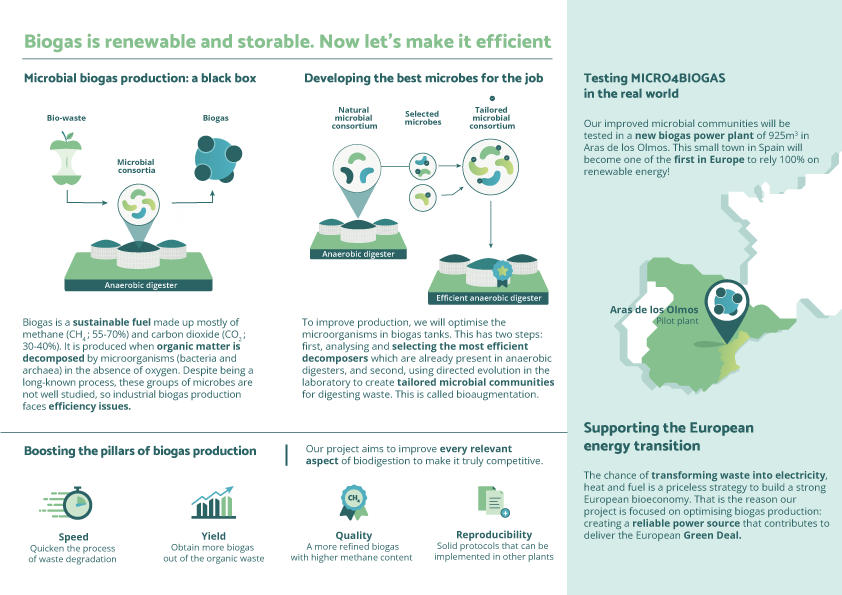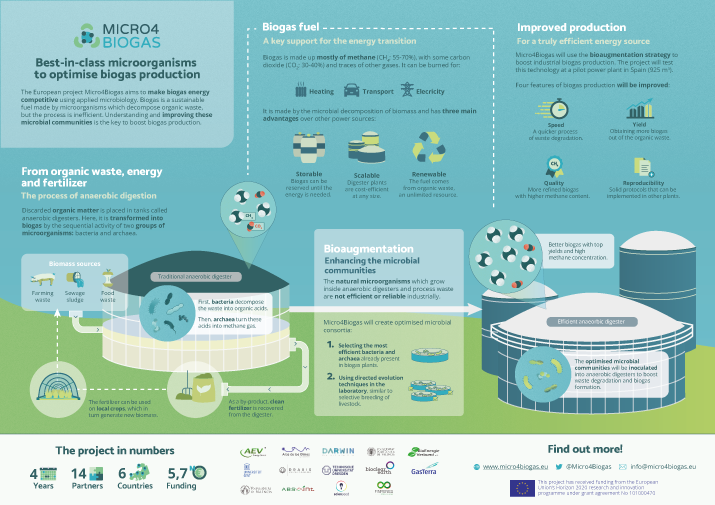Biogas has great potential to boost the energy transition, but its production requires some improvements. The Micro4Biogas project aims to transform biogas into a competitive renewable energy source. Let us guide you with 3 visual formats – an animated video, a printed brochure and poster infographic – through our project and how it will boost biogas production, bringing society one step closer to phasing out fossil fuels.
Although there has been an improvement in the development of renewable energy, we still rely heavily on fossil fuels. In fact, according to the United Nations, fossil fuels comprise 80% of the current global primary energy demand and they are the source of approximately two thirds of global CO2 emissions. The burning of fossil fuels is already having big consequences on our climate and ecosystems, for example through global warming and ocean acidification. Not only do they have a negative environmental impact, but they are also finite and will eventually run out.

This key idea — that we must abandon fossil fuels — is how our 2-minute motion graphic video about the Micro4Biogas project begins. We wanted to show how fossil fuels are polluting the environment, so we recreated a scene in which an oil spill is contaminating the sea. This video also portrays how research has been driven towards the development of renewable energy sources, which is great! But as the voiceover of the video explains, power obtained by renewables such as wind and solar usually depends on changing weather conditions and cannot be stored. That’s why we need to ensure a continuous and sustainable energy supply that can complement the power obtained by these other renewables. And here is where biogas comes into play, since it is storable, scalable, and renewable!
1. Micro4Biogas animated project video
Biogas, but better
Why did we choose biogas? You can find a concise and schematic explanation on our brochure, but we’ll sum it up here! Biogas is a sustainable fuel that contains a mixture of methane (CH4; 55-70%), carbon dioxide (CO2; 30-40%) and traces of other gases. It is obtained when organic matter is decomposed by microorganisms, namely bacteria and archaea, inside an anaerobic digester. However, the microbes that develop this process are not well studied and thus industrial biogas production faces some efficiency issues.
2. Inside pages from the printable project brochure
Through our printed brochure, which can be easily handed out at meetings and conferences, we wanted to highlight how the Micro4Biogas project aims to solve these problems by boosting the pillars of biogas production: speed, yield, quality, and reproducibility. We designated a part of the leaflet to detail these four aspects of biodigestion and the benefits that we will obtain from optimising these pillars. Now, how can we achieve that optimisation?
The survival of the fittest
Since biogas is made by microorganisms that decompose organic waste, we need to understand how these microbial communities behave to improve their production. Developing an infographic poster was the perfect way to explain our strategy online, to make biogas truly competitive. Notice how, in the infographic, we chose a horizontal distribution to show how we plan to change the status quo regarding biogas plants.
3. Micro4Biogas infographic poster
From left to right, we begin by placing the discarded organic matter in anaerobic digesters and then microorganisms transform it into biogas. Then, we’ll select the most efficient decomposers in biogas plants and tailor microbial communities for digesting waste, using directed evolution in the laboratory. In the end, these optimised microbial consortia will form the basis for novel bioaugmentation kits, which could be inoculated into anaerobic digesters for more efficient biogas production. This is a lot of work, and it will take our 14 partners from 6 different EU countries approximately 4 years. Is biogas worth all the effort?
Beyond energy production
Besides the advantages of biogas as an energy source — storable, scalable and renewable — it can also be used for waste valorisation. Organic waste is an unlimited resource for biogas production, and it can come from farming waste, sewage sludge or food waste. But that’s not all: apart from biogas, we can also obtain digestate as a by-product from the waste digestion process carried out by microorganisms. This clean fertilizer can be used on local crops, which in turn generate new biomass! We chose to represent this important cycle in our communication materials as well. For example, at the end of our motion graphic video, a truck can be seen taking the organic waste from a farm to the biogas plant, and then returning with the clean fertilizer.
By optimising the production of biogas, the Micro4Biogas project is aligned with the circular and bioeconomy goals of the European Union, towards a sustainable future. We’re excited to share more visual explainers with you during our 4-year journey. Don’t miss out on the latest updates from our blog, as well as our Twitter account!



